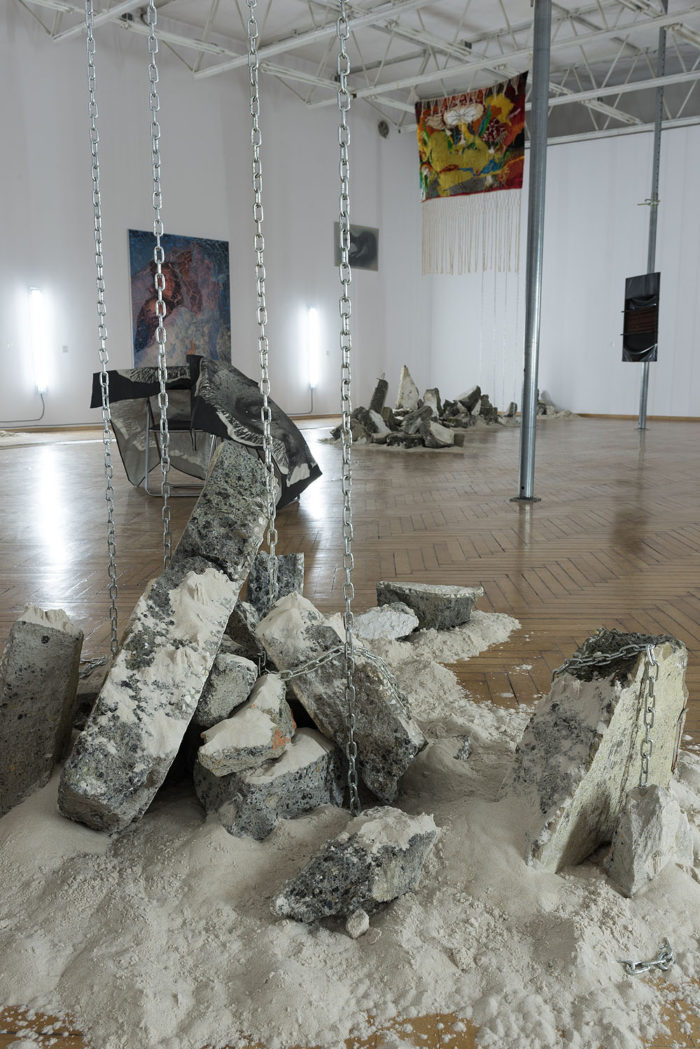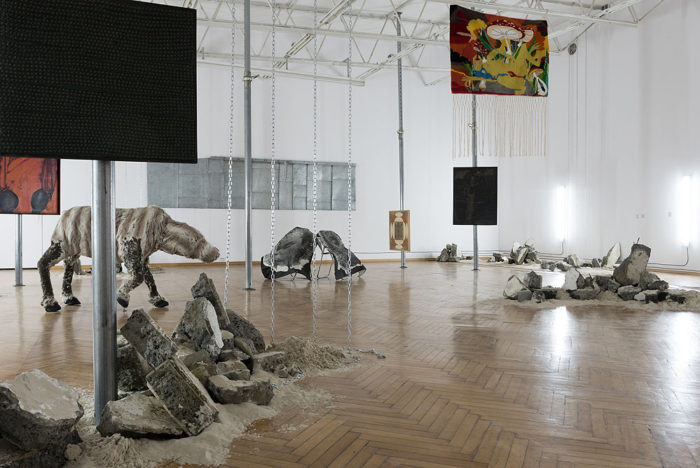Inside Job (Ula Lucińska & Michał Knychaus)
Too Dense to Sleep, 2020, exhibition environment, rubble, chains, support pillars, graphite sand, LED lights, safety grating, cables, variable dimensions


Created by the duo Inside Job, the main exhibition environment, called Too Dense to Sleep, is an unreal and disturbing space that seems suspended beyond time. The past interpenetrates with the ruins of the present here, but also with a tension caused by both enduring in a multiplicity of orders and waiting for a way out of the deadlock to open up. Lucińska and Knychaus use rubble, support pillars, or sand to evoke a situation of reconstruction, transformation, lending their work the status of a liminal space, a transition from one order to another, a strategy inspired by the famous and legendary exhibition Space and Expression (1967), curated by Marian Bogusz. One of Bogusz’s key decisions was to make exhibition spaces available to the invited artists and ask them to stage their installations there. Some were produced using building or renovation materials.
Artworks presented in this atmosphere can be interpreted in the context of dream visions. Coexisting here are spectres of history, modernist utopias, symbolic representations, animistic imaginations, and nightmarish creatures. In this sense, sleeping/dreaming appears not only as a projection of the subconscious, but also as a younger sister of death.
Inside Job (Ula Lucińska, Michał Knychaus) are an artist duo. Holding degrees from the University of Arts and the Adam Mickiewicz University in Poznań, they have presented their works on residencies: A-I-R FUTURA, Prague (2020); Residency Gurzelen, Biel/Bienne, Switzerland (2018); Test Drive, Nicosia, Cyprus (2018); Kulturfabrik Burgdorf, Switzerland (2016), in solo exhibitions (e.g. at CAVE, Wrocław; Pawilon, Poznań; :SKALA, Poznań; 9/10, Poznań; Hot Wheels Projects, Athens) as well as in group shows (e.g. at Kunsthalle Baden-Baden, Germany; TRAFO — Trafostacja Sztuki w Szczecinie; BWA Wrocław; Gdańsk Municipal Gallery; Śmierć człowieka, Warsaw; WallRiss, Fribourg, Szwajcaria; Sattlekammer, Bern; Athens Digital Arts Festival 2018, Ateny; DuflonRacz, Bern; Ostrale Biennale of Contemporary Arts, Dresden; Musrara Mix Festival, Jerusalem). In their practice, they use diverse media and materials, and the objects they build comprise multilayered environments. They are interested in processes of identity construction (including the identity of places) in the context of dynamic changes, such as the climate crisis, technological acceleration, political radicalization, and a growing anxiety about the future. Many of their works to date refer to futuristic or post-apocalyptic scenarios. In the future, they will travel with their objects to Siberia to produce their photographic documentation in one of the craters formed by thermoacidic processes caused by the melting of permafrost. A few days before arrival, they will switch to incommunicado mode.